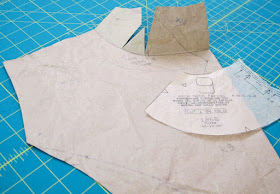RECONSIDER LINING AND POCKETS
Now all of my patches are sewn into panels, but before I can assemble the coat, I need to consider the lining and pockets. I buy deep black 90% cotton 10% spandex knit. It’s not slippery like I’d like a lining to be, but it’s nice and stretchy, but still natural feeling. I’ve learned that I prefer mostly natural fibers, but with cotton, in particular, a hint of synthetic fibers help the fabric keep its shape. Since the sweater fabric is stretchy, I need a stretchy lining to match. If I had all the money I wanted, I’d use a silk jersey knit for the lining; that would be so luxurious, but an extravagant expense, to be sure.
To pattern the lining, I would normally use my same pattern pieces minus the hem, but I want to try on the coat before I commit to my sleeve hem length. I check my patchwork against my large pattern pieces, and the patchwork pieces are all about an inch longer than the paper pieces. Hmm. I think my fabric stretched? Or was I systematically off on my piecing? Considering the error is only in the length, I think the fabric probably stretched.
The lining pieces on a coat are similar to the fashion fabric pieces with a few notable differences. Here are a few things I have learned about lining coats:
1. None of the collar pieces have lining. In other words, they have fashion fabric (felted sweaters) on both sides. In the case of the hood, I essentially made a huge, head shaped collar, and like most collars, the top and bottom are made from fashion fabric.
2. Linings are cut shorter at the hemline than fashion fabric for the corresponding pattern piece. This is to create a hem that has the fashion fabric on both sides near the hem. In my case, the main coat is already an inch longer than my pattern, so, I decide NOT to shorten my pattern before I cut the lining. It’s better to error on too long of a lining than too short of one.
3. front = front facing + front lining – overlapping seam allowances.
In other words, if you sew the front facing to the front lining, you get a piece that’s the same size as the front piece.
Since I ended remaking most of the pattern pieces, I’ll be using those instead of the lining pattern pieces that came with my pattern. I will however, use the front lining piece from the pattern since I didn’t alter my front piece.
4. back = back neck facing + back lining – overlapping seam allowances.
The only piece I have to alter is the top back piece to allow for the back neck facing. To do this, I trace the back neck facing at the top of the back piece. I move the traced line one and a quarter inches up since that’s twice my seam allowance. Then, I cut slits in the paper and fold it into place. The lining pattern is ready to go after I add a little tape.
CUT LINING
I need a big horizontal surface to cut my large lining pieces. It’s better, easier and faster if you cut them all at once. So I vacuum and mop the kitchen floor. I lay my fabric out folded in half lengthwise so I can cut my pieces two at a time. I lay out my pattern pieces on the fabric, and pin them in place. I cut two of everything, plus an extra 2 pocket pieces, since I need two pieces per pocket.
The pockets will be stretchy. I can’t decide if that’s a bad idea, but I can’t seem to think of anything intrinsically wrong with it, as long as they’re used mostly for hand cozies and not to transport pounds of cr@p. I mean, it’s not luggage, it’s a coat.
SEW SIDE SEAMS WITH POCKETS
I sew the shoulder seams of the front and back panels together. I try it on to decide how high on the side seams I should sew the pockets. I sew the 4 pocket pieces to the side seams.
I pin the side seams (including around the pocket),
and I can see that there is no way I can sew that sharp corner under the pockets on my serger.
I sew the side seams as well as I can, smoothing out the offending corners as my serger allows. Remarkably, the loopers catch the edge of the fabric at that corner nicely. I resew one of the points on my regular sewing machine, the first time overdoing it. I can tell because I try on the coat and there’s a nice pucker right where the pocket meets the side seam. So I rip it out and do it again. Fixed. The second one is easy. See pin head for placement.
The side seams come out alright, but again, there are bulky spots where the loopers didn’t catch threads, and I have to hand whipstitch to fill in the bald spots. I also broke a needle.
At this point, I realize that I should have used one of the thicker, sturdier fabrics on the shoulders. I chose to use cashmere because it’s soft. Unfortunately, it’s also much stretchier than the wool felt. I think the coat might sag a bit in the sleeves because I used cashmere all across the shoulders. I learned that next time I should use the sturdiest (heaviest) fabric across the shoulders rather than using the softest. I’m a sucker for soft; so I had to try it.





















































